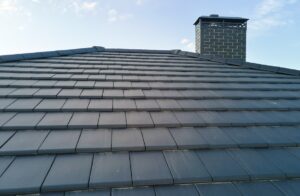Dealing with a leaky roof can be frustrating and stressful. If not addressed promptly, it could potentially lead to significant damage to your home. Detecting roof leaks early is crucial in minimizing damage and preventing costly repairs. This guide will help you identify common roof leak problems and provide simple solutions to fix them.
Detecting Roof Leaks
The first step in addressing a roof leak is to identify its source. Detecting roof leaks early can save you time, money, and the hassle of more extensive repairs. Here’s how you can detect roof leaks effectively:
Visual Inspection

Outside the House:
- Missing Shingles: Look for missing, cracked, or curled shingles. Harsh weather conditions can easily dislodge or damage shingles, creating entry points for water.
- Cracked Flashing: Inspect areas around chimneys, skylights, and vents for cracked or damaged flashing. Flashing is crucial in preventing water from seeping into your home at these vulnerable points.
- Rusted Roofing Nails: Check for rusted or exposed nails on the roof. Rust is a sign of prolonged water exposure and could indicate a potential leak.
Inside the Attic:
- Water Stains: Look for discoloration or stains on the attic ceiling and walls. These are often early signs of water infiltration.
- Mold Growth: Inspect for mold or mildew, indicating a persistent moisture problem and potential leaks.
- Damp Insulation: Feel the insulation for dampness. Wet insulation is an indicator of a leak.
Confirming the Source
To pinpoint the exact location of the leak, you can use a garden hose to simulate rainfall:
- Simulate Rainfall: Gently spray water onto different sections of the roof. Have someone inside the attic to check for water penetration.
- Check for Penetration: This method helps confirm the leak’s location by observing where the water enters the attic.
Common Roof Leak Problems
Leaks often occur in areas more exposed or prone to damage. Here are some common roof leak problems and how to address them:
Damaged or Missing Shingles
Due to harsh weather conditions, such as strong winds or hailstorms, shingles can become damaged or disappear, exposing your roof to leaks.

Solution:
- Remove Damaged Shingles: Carefully remove any damaged or loose shingles.
- Replace with New Shingles: Slide new shingles into place and secure them with nails. Ensure they are aligned correctly to avoid future leaks.
- Seal Nails: Apply a sealant over the nails to create a water-resistant barrier.
Leaks Around Skylights and Chimneys
Skylights and chimneys are common areas where leaks may emerge due to compromised flashing. Flashing prevents water seepage at the junction of your roof with these structures.
Solution:
- Inspect Flashing: Check the condition of the flashing around chimneys and skylights.
- Seal Chimney Flashing: Apply a durable, top-tier sealant to ensure it’s correctly sealed and waterproof.
- Replace Skylight Flashing: If the skylight flashing is beyond repair, replace it entirely to maintain its water resistance.
Low Nails and Nails Between Shingles
Low nails and nails positioned between shingles can lead to leaks, as they are exposed to the elements and can allow water to seep through.
Solution:
- Find Problematic Nails: Locate low nails and nails too close to the shingle seams.
- Lift Shingles: Carefully lift the shingle above the nails.
- Apply Caulk: Apply a generous amount of caulk under the shingle and over the nails to seal them.
Leaks Around Vent Pipes and Roof Vents
Vent pipes and roof vents can be problematic areas for leaks due to degraded pipe collars and inadequate seals.
Solution:
- Inspect Pipe Collars: Check the condition of the pipe collars around vent pipes.
- Replace Pipe Collars: Replace any worn-out or damaged pipe collars.
- Seal Roof Vents: Apply a premium-grade sealant around the vent openings to properly seal them.
Engaging Professionals for Roof Repair
While the strategies mentioned above can help tackle typical roof leak issues, more intricate or comprehensive repairs may require professional help. Skilled roofing contractors possess the knowledge, tools, and techniques necessary for substantial repair work. Even straightforward repairs can become complex without the right expertise.
Missteps in DYI repairs can cause more harm than good, leading to further damage or more expensive fixes later. Hiring professionals ensures quality workmanship and professional repairs.
Conclusion
Detecting roof leaks early and addressing common roof leak problems promptly can save you from more severe damage. Regularly inspecting your roof and being vigilant about changes in your home can help identify leaks early. However, don’t hesitate to seek professional assistance for significant repairs to ensure your roof remains in optimal condition. Remember, a well-maintained roof protects your home and ensures its longevity.





